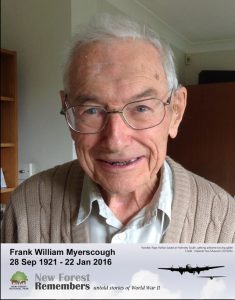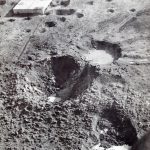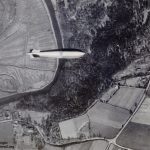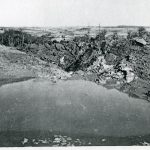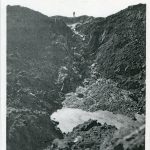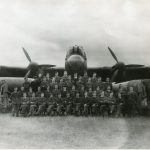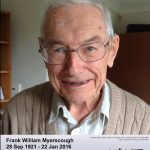Memories of a Scientific Advisor working on Grand Slam
An oral history interview with Frank Myerscough. Interview Date 08/05/2014
Frank Myerscough was born in 1921. He was evacuated to Bangor in 1939.
Frank was awarded a scholarship to Liverpool University to study engineering completing a 4 year course in 2 years achieving a 1st class honours as the top student. He was recruited by CP Snow joining the Scientific Civil Service on Solly Zuckerman’s scientific advisory group to the British Government in WWII.
At 21 years of age Frank was appointed Airborne weapons tester and designer – Royal Aircraft Establishment, Farnborough. At 22 years of age represented R.A.E on Prime Minister Winston Churchill’s special weapons committee in Whitehall. He became a Scientific Advisor to the armaments section of the Aircraft and Armament Establishment at Boscombe Down in 1943 to help develop Tallboy and Grand Slam bombs. Frank took responsibility as the bomb aimer on first test of Grand Slam at Ashley Walk.
When peace was declared in 1945 he resigned and joined Unilever at the request of the government he wrote a confidential memoir for the Scientific War Records, before moving to work for Proctor and Gamble in 1950 with whom he had a very successful career. Frank featured in an article for the P&G Associate magazine in August 2013.
Frank died peacefully at Poole Hospital on 22 January 2016 aged 94.
Interview Quick Clips:
All material is © 2018 New Forest National Park Authority.
Some extracts from Frank’s Oral History, the full transcript can be found using the link below
On Grand Slam – development and live testing
The normal process of testing designs of weapons involved the use of dummies filled with concrete or sand, materials with the density of high explosive. I saw Barnes Wallis about the testing of Grand Slam and I suggested to him that we’d lose three months at least in getting this bomb into operation if we went through the process of testing a dummy first. And he was willing to listen to me. The RAF were very unhappy about that. The RAF were unhappy because they knew that this bomb was too big to fly with the bomb doors shut. We had to have the bomb doors open and therefore there was no knowing how the airflow would go inside the bombing compartment of the aircraft And therefore there was a serious risk if we didn’t fly it appropriately, carefully, that it could impact the structure of the plane and blow it all up. So they didn’t want to do it with anything but a dummy bomb. In this impasse, I suggested that I‘d take responsibility as the bomb aimer and so I flew in the plane as the bomb aimer in the nose of the plane and the RAF – albeit reluctantly – agreed to fly it with a live bomb.
It was a very nervous process, releasing that bomb over the little country town of Fordingbridge, where it needed to be released in order to hit the target in Ashley Walk. The target in Ashley Walk had been built, or maybe modified, to simulate the submarine pens in Peenemunde, the major place for the revictualling and rearming of U-boats, and similar pens in northern France. The bomb fell 100 yards from the target, which was to be expected really.
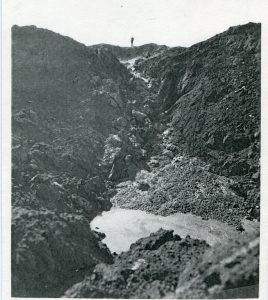
Frank looking up out of the Grand Slam crater.
The crater it made was 140 feet wide and 70 feet deep. It convinced the RAF and the Ministry that this would destroy the submarine pens, whereas all previous general purpose bombs that had been dropped on it merely chipped the concrete.
I took photographs from the air of the bomb falling over the River Avon and of the target and the crater in the Ashley Walk bombing range on the flight (these can be seen above).
There was also a photograph taken later of the armaments section of the Aircraft and Armament Experimental Establishment with the modified Lancaster bomber and Tallboy on left hand side and Grand Slam on the right and fronted by the staff, with me on the end of the front seats. The photo annotation notes that in front row from left is Frank Myerscough, (?), Flight Lt Brian Harvey, (?), Squadron Leader Evans, Group Captain Fraser (head of department), Squadron Leader Carrtier (5 unidentified officers)
Photographs were also taken of the crater with a human being standing on its edge to give an impression of the size. This enabled a decision to be made in March 1944, ‘45 (corrects himself), March ’45 to make 40 Grand Slam bombs and they were dropped on the V2 and the V1 launching pads in the Netherlands as well as on the submarine pens and soon after that the Germans sued for peace. I am not saying, though, that the two are necessarily related, it might just be a coincidence.

Another photo shows a Lancaster in flight with Grand Slam in place – the pilot of the Lancaster is Captain Bruin Purvis
On this site the Ashley Range Overview page has links to detailed pages about the targets, activities, archives and stories about the range.
Full transcription of interview recordings
Download transcription (PDF)
Interviewed by: Gareth Owen
Transcription by: Sue Jackson
Audio Editor: Cosmic Carrot
The New Forest Remembers team were told in January 2016 that Frank Myerscough had past away.
In Memory of Frank Myerscough (28 Sep 1921 – 22 Jan 2016)
http://www.myerscoughkin.com/frank-william-myerscough.html
https://www.funeralzone.co.uk/obituaries/14234


